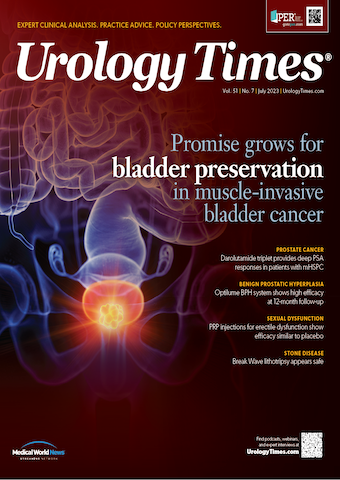Publication
Article
Urology Times Journal
Break Wave Lithotripsy appears safe and efficacious in urolithiasis
Author(s):
"In summary, it was safe and effective. There [were] no serious adverse events...and the vast majority of patients received no anesthesia with very similar results to shock wave lithotripsy,” said Ben H. Chew, MD, MSc, FRCSC.
Break Wave Lithotripsy was found to be safe and effective in the treatment of patients with urolithiasis, according to data presented at the 2023 American Urological Association Annual meeting in Chicago, Illinois.1
The primary efficacy endpoint was stone free rate or fragments of 4 mm or smaller on CT at 8-12 weeks.

The non-invasive technology was assessed in a first-in-human, prospective clinical trial (NCT03811171) that enrolled patients with ureteral (n=18) or renal stones (n=26).
“In a 5-center study, we [looked at] 44 patients. The majority, 86% of them, received either no medication or just a mild analgesic,” said lead author, Ben H. Chew, MD, MSc, FRCSC, in a presentation on the results. Chew is an associate professor in the department of Urologic Sciences at the University of British Columbia in Vancouver, Canada.
Patients included in the study were treated in the operating room, office/clinic, or emergency department. They were given varying therapy dose levels of up to 8MPa of acoustic pressure for 30 minutes. Participants were followed for 90 days following the procedure. The primary efficacy endpoint was stone free rate or fragments of 4 mm or smaller on CT at 8-12 weeks.
The investigators observed stone fragmentation among 88% of patients. In total, 70% were stone free or had fragments 4 mm or smaller on CT.
The optimal dose setting was identified and given to 36 of 44 patients, of whom 75% had fragments 4 mm or smaller and 58% were completely stone free. Among lower pole patients, 71% had fragments 4 mm or smaller and 29% were completely stone free.
The rate of retreatment with shock wave lithotripsy or ureteroscopy within 90 days was 7%.
“The success rate was very similar to shock wave, with 29% for lower pole. Looking at distal ureteral stones, the success rate was very high, around 89%. In summary, it was safe and effective. There [were] no serious adverse events, no subcapsular hematomas, no sepsis, no steinstrasse, and the vast majority of patients received no anesthesia with very similar results to shock wave lithotripsy,” said Chew during the presentation.
In regard to further research, Chew added, “We're going to go on to the pivotal study with a Gen 2 device, which has both better imaging, as well as a wider focus and greater depth of penetration. We're hoping to see an improvement on that.”
Reference
1. Chew BH, Harper JD, Sur RL, et al. Break Wave Lithotripsy for urolithiasis: results of the first-in-human international multicenter clinical trial. Presented at: American Urological Association Annual Meeting, April 28-May 1, Chicago. Abstract LBA01-14

Newsletter
Stay current with the latest urology news and practice-changing insights — sign up now for the essential updates every urologist needs.


























